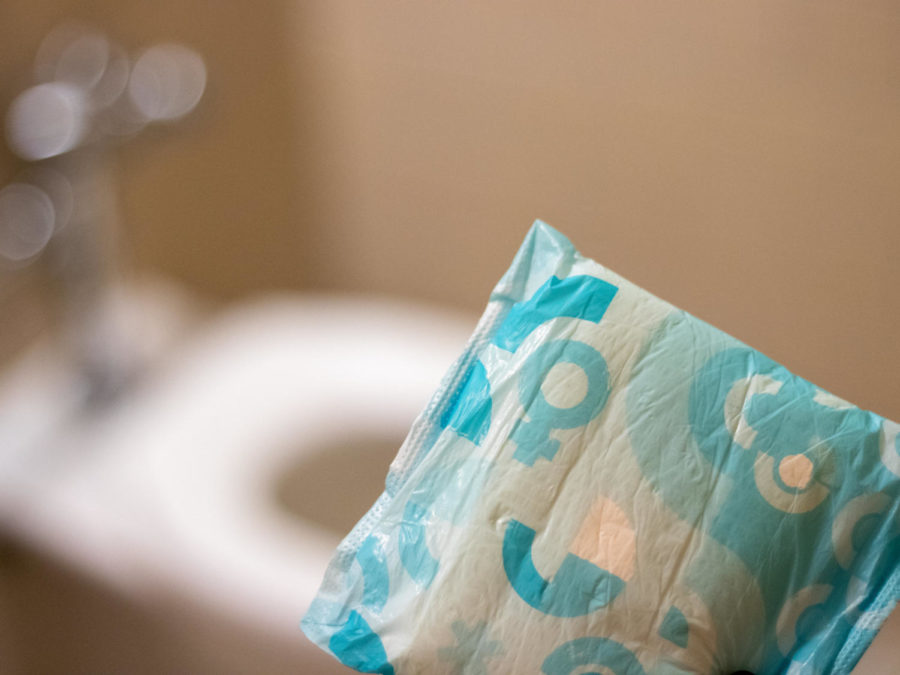Many women, especially those living in the United States, are likely to recognize a common fixture in public restrooms: the menstrual product disposal bin.
These bins are usually made of metal or plastic and are mounted to the inner stall walls of women’s bathrooms. They provide designated disposal areas for used menstrual products such as pads and tampons.
At the University of Massachusetts, depending on which building’s bathroom you use, some bins include a very peculiar feature.
About half of the bins have a frontal dispenser filled with small, pink plastic bags printed with a logo that says “Scensibles.” Bathrooms in older buildings on campus such as the Fine Arts Center, Holdsworth Hall, Thompson Hall, Hasbrouck Laboratory and New Africa House have Scensibles dispensers. Bathrooms in new constructions, renovated buildings (with the exception of the Integrative Learning Center), residence halls and dining commons do not.
Scensibles feature a flowery pink print pattern and are shaped identically to dog waste bags when unraveled. A small diagram with instructions is printed around the dispenser. It reads: “Do not flush! Dispose of your tampon, pad or panty liner in a Scensibles bag. Pull. Insert and tie. Toss into waste bin.” Underneath the logo is the additional, albeit vague line: “Protect health and the environment – Biodegradable Plastic.”
Even from the beginning, I thought that these bags were unnecessary. Pads and tampons are almost always packaged with their own plastic disposal wrappers. A big selling point for Tampax brand tampons is their implementation of resealable adhesive onto their wrappers for more convenient, built-in disposal. While menstrual education for young girls differs depending on the school curriculum, most are taught that wrapping used sanitary products in the provided wrapper or a piece of toilet paper is a sufficient habit. For many of my friends and I, this habit has always remained the go-to. No additional disposal bags were ever necessary.
So where did Scensibles come from? And why does UMass use them?
According to the Scensibles website, these disposal bags are meant to help prevent women from flushing their used period products down the toilet, thus limiting plumbing damages and protecting product waste from entering waterways. According to a 2014 study by the Journal of the Institution of Environmental Sciences, around 2.5 million tampons, 1.4 million sanitary napkins and 700,000 liners are flushed every day. Disposable period products have components made of plastic and other nonbiodegradable materials which wreak havoc on waterways and marine environments when flushed.
While this addresses an extremely valid environmental issue, Scensibles’ claim that their little pink plastic bags are going to make substantial change is inherently flawed.
Firstly, Scensibles bags are made of plastic. While the labels around the dispensers on campus say that the plastics are “biodegradable,” the Scensibles website states that the bags are made with only “20 percent recycled material.” The rest of it? High-density polyethylene (HDPE). HDPE is an everyday packaging plastic that can take nearly 450 years to biodegrade. The excess plastic produced most likely cancels out any of the positive effects of its flush prevention.
Furthermore, campaigns to educate women about the negative impacts of flushing their products would be equally as effective in preventing flushing. Signs and notices inside the stalls could easily be included in these campaigns. In all honestly, those who are already careless enough to flush their products down the toilet despite the environmental effects probably aren’t going to suddenly start using the provided Scensibles bags.
To support their product, Scensibles also claims that menstrual products produce a “repulsive smell,” are “an eyesore,” and carry “contagious viruses and blood borne pathogens.” While the absence of adequate janitorial maintenance in bathrooms can cause unsanitary conditions, this is the case for all parts of the bathroom, not just the menstrual disposal bin.
A 2018 article written by Camilla Rostvik from the University of St. Andrews states: “It is notable how persistent myths about menstruation are in an industry profiting from women.” She continues, “Ideas about menstrual blood as toxic have shaped the British industry into a successful solution for an exaggerated problem. There is little scientific evidence to suggest that menstrual product waste is toxic, but the industry continues building its case on this assertion.”
Women’s bathrooms with adequate maintenance are not the repulsive contamination zone that Scensibles depicts them as. Ultimately, Scensibles makes vague claims and uses menstrual stigma to create a manufactured necessity for their product.
No response was heard from UMass maintenance services after reaching out with questions regarding the timeline of when Scensibles were implemented or the decisions over which buildings received them. According to current UMass upperclassmen I spoke to, Scensibles have been in bathrooms for the past few years at the very least.
A possible factor behind implementation could be the recent surge in advocacy for destigmatization and universal access to free menstrual products on campus. This movement has been led by the UMass chapter of PERIOD Inc. Various publications in the Daily Collegian have editorialized the need for menstrual equality, including a 2019 opinion piece and a more recent 2021 letter.
As of this semester, only a few select classroom buildings provide free period products. Residence hall bathrooms — a place where they would be most helpful — still do not have them.
While it’s probably a good idea for UMass to just ditch Scensibles, the most important thing that UMass needs to do is be decisive and consistent with their choices as to where menstrual products are provided. The lack of menstrual equity is not something that can be simply solved by investing in plans and products that simply look good on paper.
Kelly McMahan can be reached at [email protected].



















